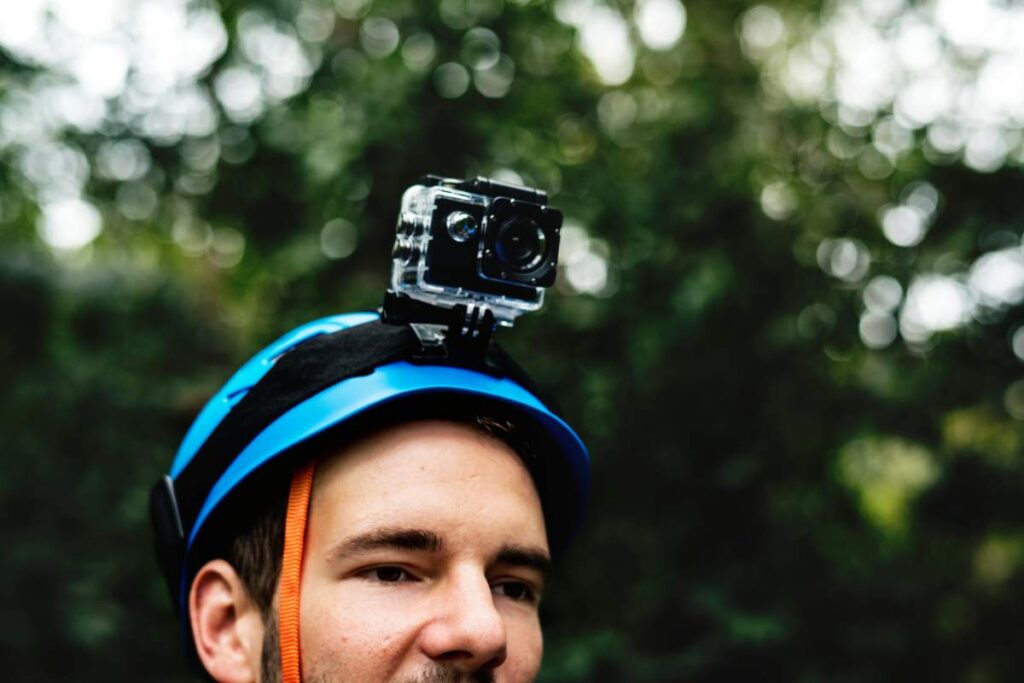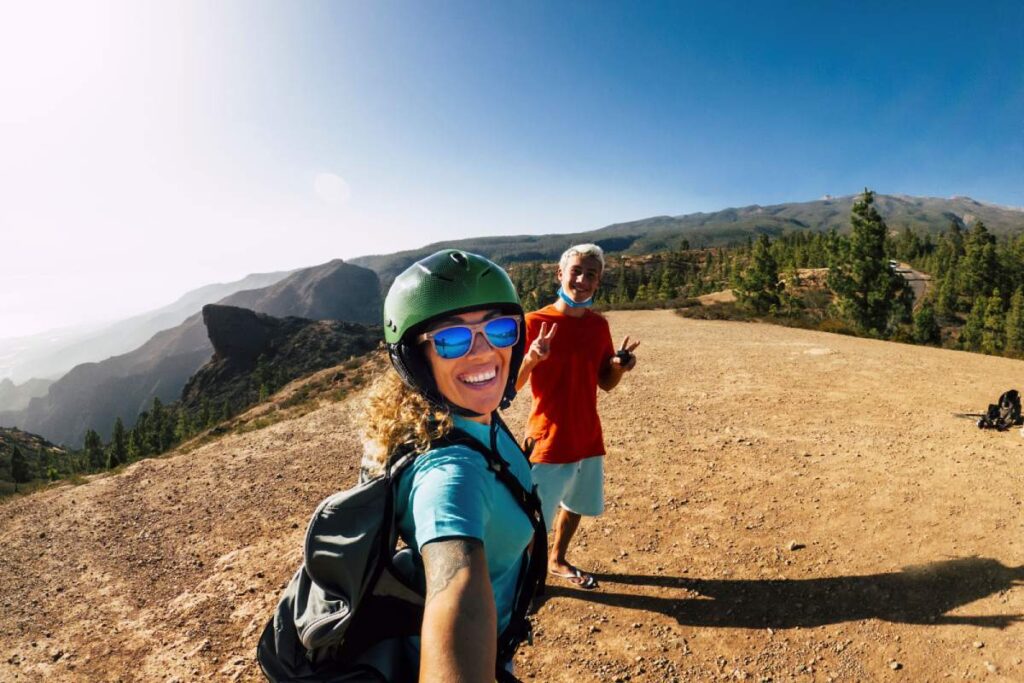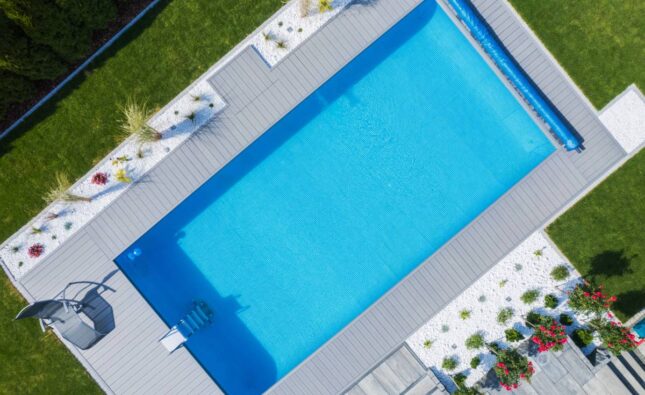The GoPro Hero 10 Black is the newest in a long series of Hero action cameras dating back to 2005. Because of its new GP2 CPU, it’s the most refined and powerful GoPro ever, but it’s still just a small advance over its Hero 9 Black predecessor.
Every now and again, GoPros make a significant advancement: the Hero 5 Black was waterproof without the need for a case, and the Hero 7 Black featured HyperSmooth stabilization. The Hero 10 Black, despite its memorable moniker, isn’t one of those models. However, it refines (and fixes) the majority of the new capabilities seen on the Hero 9 Black, while also providing a smattering of new shooting modes and improved usability.
The Hero 10 Black has the same 23MP 1/2.3-inch sensor as its predecessor and is waterproof to 10 meters, but it’s the new GP2 processor that unlocks the majority of its additional capabilities. Among them are new shooting modes, such as 5K/60p, 4K/120p, and 2.7K/240p possibilities. The last two are entertaining, slow-mo affairs that are ideal for social media cut-scenes orb-cam video, especially because GoPro’s new Quik software will gladly perform some editing for you.
Other enhancements include a considerably more snappy touchscreen interface (the Hero 9 Black fell short in this regard), a convenient new wired data transfer option for phones, and some under-the-hood picture quality enhancements such as local tone mapping and enhanced low-light noise reduction. Although there are some minor gains in video quality as a consequence, the Hero 10 Black can only do so much with its relatively tiny image sensor.
Most people will be more interested in the fact that HyperSmooth 4.0 remains the greatest action camera video stabilization technology available, while watersports enthusiasts will appreciate the effective new hydrophobic coating on its toughened-up lens cover.
It’s a pity the Hero 10 Black doesn’t have a bigger sensor like the Insta360 One R 1-inch model, and GoPro’s latest forays into a webcam and live streaming continue to be limited in terms of quality (still just 1080p) and platform compatibility (although it is now possible to Livestream with HyperSmooth stabilization).
Despite its modest changes, the GoPro Hero 10 Black refines the image-quality advances achieved by the Hero 9 Black, and it’s the most user-friendly, powerful action camera you can purchase – if not the greatest value.
Price and release date for the GoPro Hero 10 Black
When purchased separately, the GoPro Subscription, formerly known as GoPro Plus, costs $49.99 / £49.99 / AU$69.99 per year, and you’ll be set up to auto-renew annually if you purchase the Hero 10 Black with a subscription, though you can avoid this by cancelling the subscription at any time during the first year.
Given that you are not required to renew the subscription, it is most likely the best method for most individuals to get the Hero 10 Black. The GoPro Subscription includes unlimited cloud storage for full-quality films and photographs, automatic uploads, full access to the Quik app’s editing capabilities, 50% off all accessories (up to 10 per year), live-streaming assistance, and replacements for damaged cameras (for a fee, depending on the camera).
GoPro will continue to offer its existing camera models at their present rates, with no models being discontinued. This includes the Hero 9 Black ($349 / £329 / AU$529) from last year, as well as the Hero 8 Black ($279 / £259 / AU$419) and GoPro Max ($399 / £379 / AU$659). All of those prices include a GoPro membership, but you can also purchase them without one.

Design
- A tougher lens cover with a water-repellent coating has been added.
- The rear touchscreen and menus are significantly more snappy.
- Otherwise, the Hero 9 Black is practically similar.
Physically, the GoPro Hero 10 Black is almost similar to its predecessor. The new model’s elegant blue branding on the front and side are the only exterior differences between it and the Hero 9 Black.
However, GoPro has made a few minor changes, the most notable of which is the redesigned lens cover, which is ideal for watersports enthusiasts. This now has a water-repelling hydrophobic coating, and it truly works — we tested the Hero 10 Black and its predecessor underwater, and the new lens cover repelled water substantially better, leaving no droplets to obstruct your vision.
This lens cover also appears to have better scratch resistance, which was more difficult to test on our loan sample – though an unplanned test in which our head-mounted GoPro flew off after a heavy zip-line landing and came to rest in some jagged wood chips left no visible marks on the lens. This lens cover, like the Hero 9 Black, is removable and replaceable if it sustains serious damage, such as a direct hit from an Airsoft pellet, or if you want to add ND (neutral density) filters.
The Hero 10 Black is actually 5g lighter than its predecessor, though we can’t tell where GoPro saved weight, and it offers no practical benefits in any case. The camera, like before, has folding ‘fingers’ in its base for mounting directly to accessories. These were first seen on the Hero 8 Black, and they eliminate the need to fiddle with extra housing to secure the camera to your helmet.
If you’re unfamiliar with the Hero 9 Black, here’s a short rundown of the other design elements that the Hero 10 Black has inherited. For vloggers, there’s a 1.4-inch front LCD that GoPro claims is now smoother when showing movement than before, thanks to higher frame rates enabled by its GP2 processor (more on that later). Despite the fact that this screen is so little, we couldn’t detect the difference between it and its predecessor.
The upgraded 2.27-inch back touchscreen is much more apparent. GoPro claims that this has “enhanced touch sensitivity,” however the main improvement is due to the power of the GP2 CPU. One of our major complaints about the Hero 9 Black was its sluggish, unresponsive rear screen, and while it did improve with a recent firmware update, it’s still nowhere near as responsive as the Hero 10’s touchscreen.
To be clear, this is how Hero 9 Black should have performed from the start, so it’s far from a victory for its replacement. However, the speedier startup speeds (it’s usually ready to go in less than five seconds, compared to eight seconds for the Hero 9 Black) and smartphone-like snappiness make it significantly more fun to use than last year’s frequently irritating experience.
When you open the side door of the Hero 10 Black, you’ll discover the same 1,720mAh battery as its predecessor. This, like the 1.4-inch front LCD, was introduced on the Hero 9 Black, so it’s something to keep in mind if you’re moving from a previous GoPro — your older 1,220mAh batteries won’t work here.
A microSD card slot and a USB-C port flank the battery cover. The latter is intended for charging, but it may also be used to connect transmit video to your Hero 10 Black (this is about 50 percent faster than wireless transfers). It’s an easy procedure for Android phones, which just need a USB-C to USB-C connection, but iPhone users will require the Apple Lightning-to-USB camera converter, as well as a conventional USB-A to USB-C cable.
Overall, the Hero 10 Black is a tough pocket camera that’s waterproof to 10 meters and seems a touch more refined than its predecessor.

Features
- The sensor is the same 23.6MP, 1/2.3-inch sensor as the Hero 9 Black.
- The new GP2 processor enables significant improvements to shoot modes.
- It is now possible to broadcast while using HyperSmooth stabilization.
The GoPro Hero 9 Black debuted a new picture sensor last year. It featured the same sensor size as previous GoPros (1/2.3-inch), but it had a greater resolution, allowing it to be the first GoPro to record 5K footage. The Hero 10 Black has the same image sensor, but it is paired with a new GP2 CPU, which unlocks several useful additional abilities.
The GP2 chip is the first significant processing change in GoPros in four years, and it’s long needed. The GP1 failed to meet the additional demands imposed by the Hero 9 Black’s dual displays and higher-resolution sensor, and its replacement is responsible for almost all of the advancements seen in the Hero 10.
What are these enhancements? Along with the previously noted improvements to startup speeds and touchscreen efficiency, there are also new frame-rate options that make it a more adaptable action camera. The chart below summarizes the new modes, but the slow-motion choices – including a long-awaited 4K/120p mode – are especially entertaining.
Performance
- Because the battery life remains constant, it is important to have replacements on hand.
- The built-in mics are identical to those found in the Hero 9 Black.
- New slo-mo options are a welcome addition to cut sequences.
While the GP2 processor of the Hero 10 Black makes it a more polished, pleasant camera to operate than its predecessor, several parts of its performance remain typical of GoPro.
Unfortunately, one of them concerns battery life and overheating. The battery in the 10 Black is the same as the one in the Hero 9 Black, and it is bigger at 1,720mAh than the batteries in all prior GoPros. However, the Hero 10 Black’s more demanding dual displays and high frame-rate settings use a large portion of its storage.
In our battery test, we got 72 minutes of recording from Hero 10, with the camera shooting a continuous 4K/30p clip with HyperSmooth enabled and the screen brightness set to 50%. This included two pauses for overheating when the camera shut down under pressure.
This is actually a bit less than what we received with the Hero 9 Black, and it’s comparable to what we got from the Hero 8 Black, proving that the old GoPro adage is true: always take a backup battery or two with you. During a real-world test at an adventure park, our fully charged Hero 10 Black lasted three and a half hours before dying. That was a demanding day for the camera, with plenty of menu swiping and frame-rate switching, but it’s also a regular day out for a GoPro.
Another long-standing GoPro flaw, audio, hasn’t improved since the Hero 9 Black. In calmer areas, the microphones deliver adequate sound quality, and speech isolation and wind noise management are unquestionably improved than prior GoPros. However, if you want to ensure that your audio matches the quality of your video, we suggest obtaining the Media Mod adapter and either putting in a lavalier mic or choosing a wireless alternative like the Rode Wireless Go II.
However, Hero 10 Black’s new slow-mo modes (4K/120p and 2.7K/240p) are a lot of fun and a wonderful way to spice up your social media movies. There is a notable quality reduction while filming in these settings, especially if you are not in direct sunlight, but the flexibility these modes provide, especially when paired with horizon-leveling and HyperSmooth stabilization, makes them one of the key reasons to upgrade from an earlier GoPro.

Image and video quality
GoPro has made several tweaks to the Hero 10 Black’s default video settings. The action camera manufacturer seems to have outgrown its distinctive saturated aesthetic, opting for a more natural approach out of the box.
There are now three color options to pick from. Previously, you could choose between a ‘GoPro’ color profile (which generated vibrant, strong colors) and a ‘flat’ one that you could then grade. But now there’s a new ‘Natural’ profile that’s the new default, and we’re huge lovers of it.
GoPro has also reduced the sharpness to the medium by default (a nice move), but we like to shoot with it on ‘low’ with the bit-rate set to ‘high’ (or 100Mbps) for the best picture quality. When compared to footage shot on the Hero 9 Black with the same settings, the results were similar, but with subtle improvements due to the new local tone mapping.
Still, with that new sensor, the Hero 9 Black has previously made significant gains in areas like detail over prior GoPros, and you’re unlikely to detect a significant change here unless you’re really pixel-peeping. The 5K/60p option is good to have, albeit not ideal for action sequences owing to the more restricted stabilization, but it’s the new slow-mo settings that are the most entertaining.
The Hero 10’s slower frame rates of 120p and 240p (especially the latter) still have a softness to the footage, but the ability to record 4K/120p and 2.7K/240p elevate them from novelty to something actually practical. GoPro’s HyperSmooth remains the finest on an action camera, and the improvements to horizon leveling are a great addition.
On the other hand, not many people purchase a GoPro to capture stills – and although the Hero 10 is a decent, waterproof stand-in for your smartphone, competitors have left it a bit behind.
The results are quite vivid and colorful in excellent light, and SuperPhoto may help you recover some highlight elements from regions like the sky. However, the Hero 9 Black’s 3MP resolution boost will be insignificant to most users, and in difficult scenes – including low-light situations – it simply cannot compete with Apple, Google, and Samsung’s computational pipelines.
The ability to shoot in raw is available, but only in the ‘wide’ fisheye perspective, and shadow recovery is restricted with a 1/2.3-inch sensor.
Perhaps the most prudent approach to GoPro snapping is to just accept the sub-smartphone quality and embrace the ease of ‘frame grabs,’ which now allow you to capture marginally enhanced 15.8MP stills from 5.3K video (or 19.6MP from 5K 4:3 footage). The photos you obtain from doing this are unlikely to be found on your phone’s camera roll, and the GoPro’s ability to wander into perilous terrain is still one of the major reasons to acquire one.






